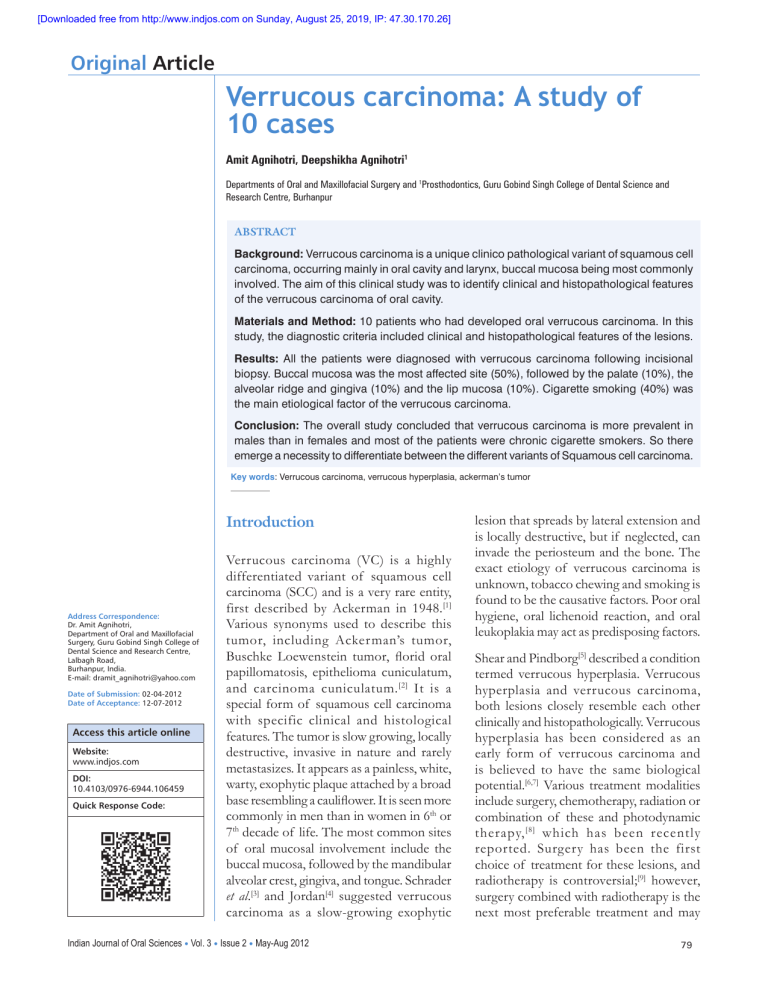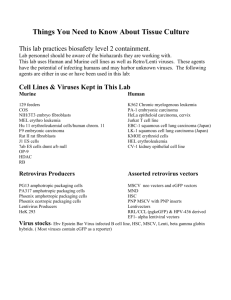
[Downloaded free from http://www.indjos.com on Sunday, August 25, 2019, IP: 47.30.170.26] Original Article Verrucous carcinoma: A study of 10 cases Amit Agnihotri, Deepshikha Agnihotri1 Departments of Oral and Maxillofacial Surgery and 1Prosthodontics, Guru Gobind Singh College of Dental Science and Research Centre, Burhanpur ABSTRACT Background: Verrucous carcinoma is a unique clinico pathological variant of squamous cell carcinoma, occurring mainly in oral cavity and larynx, buccal mucosa being most commonly involved. The aim of this clinical study was to identify clinical and histopathological features of the verrucous carcinoma of oral cavity. Materials and Method: 10 patients who had developed oral verrucous carcinoma. In this study, the diagnostic criteria included clinical and histopathological features of the lesions. Results: All the patients were diagnosed with verrucous carcinoma following incisional biopsy. Buccal mucosa was the most affected site (50%), followed by the palate (10%), the alveolar ridge and gingiva (10%) and the lip mucosa (10%). Cigarette smoking (40%) was the main etiological factor of the verrucous carcinoma. Conclusion: The overall study concluded that verrucous carcinoma is more prevalent in males than in females and most of the patients were chronic cigarette smokers. So there emerge a necessity to differentiate between the different variants of Squamous cell carcinoma. Key words: Verrucous carcinoma, verrucous hyperplasia, ackerman’s tumor Introduction Address Correspondence: Dr. Amit Agnihotri, Department of Oral and Maxillofacial Surgery, Guru Gobind Singh College of Dental Science and Research Centre, Lalbagh Road, Burhanpur, India. E‑mail: dramit_agnihotri@yahoo.com Date of Submission: 02‑04‑2012 Date of Acceptance: 12‑07‑2012 Access this article online Website: www.indjos.com DOI: 10.4103/0976-6944.106459 Quick Response Code: Verrucous carcinoma (VC) is a highly differentiated variant of squamous cell carcinoma (SCC) and is a very rare entity, first described by Ackerman in 1948.[1] Various synonyms used to describe this tumor, including Ackerman’s tumor, Buschke Loewenstein tumor, florid oral papillomatosis, epithelioma cuniculatum, and carcinoma cuniculatum. [2] It is a special form of squamous cell carcinoma with specific clinical and histological features. The tumor is slow growing, locally destructive, invasive in nature and rarely metastasizes. It appears as a painless, white, warty, exophytic plaque attached by a broad base resembling a cauliflower. It is seen more commonly in men than in women in 6th or 7th decade of life. The most common sites of oral mucosal involvement include the buccal mucosa, followed by the mandibular alveolar crest, gingiva, and tongue. Schrader et al.[3] and Jordan[4] suggested verrucous carcinoma as a slow‑growing exophytic Indian Journal of Oral Sciences Vol. 3 Issue 2 May-Aug 2012 lesion that spreads by lateral extension and is locally destructive, but if neglected, can invade the periosteum and the bone. The exact etiology of verrucous carcinoma is unknown, tobacco chewing and smoking is found to be the causative factors. Poor oral hygiene, oral lichenoid reaction, and oral leukoplakia may act as predisposing factors. Shear and Pindborg[5] described a condition termed verrucous hyperplasia. Verrucous hyperplasia and verrucous carcinoma, both lesions closely resemble each other clinically and histopathologically. Verrucous hyperplasia has been considered as an early form of verrucous carcinoma and is believed to have the same biological potential.[6,7] Various treatment modalities include surgery, chemotherapy, radiation or combination of these and photodynamic therapy, [8] which has been recently reported. Surgery has been the first choice of treatment for these lesions, and radiotherapy is controversial;[9] however, surgery combined with radiotherapy is the next most preferable treatment and may 79 [Downloaded free from http://www.indjos.com on Sunday, August 25, 2019, IP: 47.30.170.26] Agnihotri and Agnihotri: Verrucous carcinoma: A study of 10 cases have benefits, particularly in cases of extensive lesions. Recurrence rate is high in cases, in which either irradiation or surgery alone is performed. The purpose of this study is to discuss our experience with 10 cases of oral verrucous carcinoma with an analysis of the literature and to identify the clinical relationship between verrucous carcinoma and its similar pathological entities. Materials and Method 10 cases reported to the department of oral and maxillofacial surgery. The diagnosis was confirmed by clinical and histopathological features of the lesions. All patients were treated with surgery as their initial management. The follow‑up time ranged from 9 to 13 months. Results The clinical details are summarized in Table 1. Among the 10 patients (age range: 32‑67, mean age: 49.9 years, 8 males and 2 females in a ratio of 4:1 in sequence), lesions affected a variety of intraoral sites. The buccal mucosa was the most affected site (50%), followed by the palate (10%), the gingival and alveolar crest (10%), the retromolar trigone (10%) and the lip mucosa (10%), respectively. Patients’ medical history revealed no systemic diseases. Clinically, all the lesions were cauliflower‑shaped exophytic lesions [Figure 1]. One patient also had an exophytic growth extending to the palate associated with the lesion [Figure 2], and 1 patient had a leukoplakic area extending to the lip mucosa associated with the lesion [Figure 3]. Four patients had exophytic growth on buccal mucosa [Figure 4]. Out of 10 patients, 4 patients were smokers of cigarettes alone. Among these patients, 1 had smoked cigarettes for 14 years (more than one pack a day), and 3 had been smoking for 30 years (more than two packs a day). In the study, 1 patient was using alcohol and cigarettes together for 25 years, and 1 was using tobacco and cigarette together for 15 years, whereas 1 patient was using tobacco alone for 12 years. 2 patients had no possible etiologic factors. No regional lymph node involvement was found in an extraoral examination of all cases. An incisional biopsy was taken from all lesions, and the specimens were examined histopathologically. Verrucous carcinoma was diagnosed following histopathological examination of the incisional biopsy specimens. General histopathological characteristics of the specimens revealed acanthosis, papillomatosis, and hyperkeratosis of the epithelium of the lesion, continuing with characteristics of healthy mucosa [Figures 5-7]. Squamous epithelial cell composition of the tumors did not give a definite atypical character, but showed blunt rete processes toward the subepithelial area. Lymphocyte infiltration was noted in the periphery of the tumor islands. All of the patients were treated with surgery alone. Elective neck dissections were performed in all 10 patients (100%) as part of their initial surgical treatment. All of the neck specimens were negative for metastasis after detail pathology examination. For the repair of surgical defects, 2 patients (20%) had free flap reconstructive surgeries, which were performed by a plastic surgeon, and others had reconstruction with buccal fat pad. Table 1: Clinical summary of the patients Age Sex Location Possible etiological factor Treatment done Tobacco chewing Elective neck dissection and reconstruction done with free flap Elective neck dissection and reconstruction done with buccal fat pad Elective neck dissection and reconstruction done with buccal fat pad Elective neck dissection and reconstruction done with buccal fat pad Elective neck dissection and reconstruction done with buccal fat pad Elective neck dissection and reconstruction done with buccal fat pad Elective neck dissection and reconstruction done with buccal fat pad Elective neck dissection and reconstruction done with buccal fat pad Elective neck dissection and reconstruction done with free flap Elective neck dissection and reconstruction done with buccal fat pad 34 M 32 M Buccal mucosa, Gingiva and alveolar ridge Gingiva and alveolar ridge 48 M Buccal mucosa Unknown etiology 61 F Hard palate Cigarette smoking 55 M Lip mucosa Cigarette smoking 43 M Retromolar trigone 67 F Buccal mucosa Tobacco chewing and Cigarette smoking Cigarette smoking and alcohol 49 M Buccal mucosa Leukoplakia 47 M Mandible, PAC Cigarette smoking 63 M Buccal mucosa Unknown etiology Cigarette smoking Follow‑up period 10 months 12 months 12 months 13 months 11 months 12 months 12 months 13 months 12 months 9 months Avg. 49.9 Abbreviations: M: Male, F: Female, PAC: Posterior alveoler crest 80 Indian Journal of Oral Sciences Vol. 3 Issue 2 May-Aug 2012 [Downloaded free from http://www.indjos.com on Sunday, August 25, 2019, IP: 47.30.170.26] Agnihotri and Agnihotri: Verrucous carcinoma: A study of 10 cases Figure 1: Cauliflower‑shaped exophytic lesions Figure 2: Exophytic growth extending to the palate associated with the lesion Figure 3: Leukoplakic area extending to the lip mucosa associated with the lesion Figure 4: Exophytic growth on buccal mucosa Figure 5: Microscopic aspects supporting diagnosis of verrucous carcinoma. Note the broad pushing blunt squamous epithelial downgrowths that are diagnostic of verrucous carcinoma (Haematoxylin and Eosin, x 4) The 1‑year overall survival rate and tumor control rate was 100%. At the time of follow‑up, no patient had suffered from recurrence in the primary site or neck area. Indian Journal of Oral Sciences Vol. 3 Issue 2 May-Aug 2012 Figure 6: Papillomatosis and hyperkeratosis of well differentiated squamous epithelium with keratin plunging (x 10 magnification – Hematoxylin and Eosin staining) 81 [Downloaded free from http://www.indjos.com on Sunday, August 25, 2019, IP: 47.30.170.26] Agnihotri and Agnihotri: Verrucous carcinoma: A study of 10 cases always large, exophytic, soft, fungating, slow growing neoplasms with a pebbly mamillated surface.[9] The lesion appears as a diffuse, well‑demarcated, painless, thick plaque with papillary or verruciform surface projections resembling a cauliflower.[11] Figure 7: Histological details of an area with mild basal cytological atypia: vesicular nuclei with prominent eosinophilic nucleoli (Haematoxylin and Eosin, x 40) Discussion Verrucous carcinoma most of the times goes unrecognized due to benign behavior of tumor.[10] Verrucous Carcinoma (Snuff Dipper’s Cancer; Ackerman’s Tumor) is a variant of oral squamous cell carcinoma characterized by a predominantly exophytic overgrowth of well‑differentiated keratinizing epithelium having minimal atypia and with locally destructive pushing margins at its interface with underlying connective tissue.[1,6,7] Verrucous carcinoma (VC), first described in 1948 by Lauren V. Ackerman, is a distinct variant of differentiated SCC with low grade malignancy, slow growth and no or only low metastatic potential.[9] The tumor may also be found on different sites including skin, paranasal sinus, bladder and anorectal region, male and female genitalia, sole of the foot, and ear.[9] It is often associated with long‑term use of smokeless tobacco although examples occur among non‑users.[11] Schrader et al,[3] and Jordan[4] have reported that verrucous carcinomas were slow‑growing, exophytic, well‑demarcated hyperkeratotic lesions. These typically present as extensive, white, and warty lesions. All the lesions in this case series were similar in clinical behavior and aspect. The etiology of verrucous carcinoma is not well‑defined. Human papilloma virus (HPV) has been considered one of the causative factors.[11] Smoking seems highly associated with the development of mucosal verrucous carcinoma of the neck and head. Poor oral hygiene, presence of oral lichenoid, and leukoplakic lesions may act as predisposing factors. In Asia, leukoplakia is known to be associated with smoking, smokeless tobacco, and chewing habits and a synergistic effect has also been found.[13] Shear and Pindborg[5] reported that out of 28 patients with verrucous lesions, 24 (86%) used tobacco, and one was an areca quid chewer. Tobacco appears to be a major factor in causation of verrucous lesions. In our patients, cigarette smoking seemed the most causative factor among those mentioned above. Verrucous hyperplasia and verrucous carcinoma are indistinguishable clinically.[6] verrucous hyperplasia probably represents a morphological variant of verrucous carcinoma by Slootwage and Muller[13] (1983). An essential feature in distinguishing verrucose hyperplasia from verrucose carcinoma is the location of the thickened epithelium with respect to adjacent normal appearing epithelium. In hyperplasia, most of the hyperplastic broadened rete ridges lay above the adjacent normal epithelium while verrucous carcinoma on contrary exhibits a downward growth pattern of otherwise similar rete ridges.[14] Verrucous carcinoma is found predominantly in men older than 55 years of age. In areas where women are frequent users of spit tobacco, however, elderly females may predominate. In our study, the men predominated, and the mean age was 49.9 years. In our study, we found the male and female ratio was 4:1, which was similar to the study done by Hansen et al.[12] Shear and Pindborg [5] noted that 36 of 68 patients had verrucous hyperplasia associated with leukoplakic lesions. Similarly, our study revealed 1 patient having verrucous hyperplasia accompanied by leukoplakic lesions. Differential diagnosis can be made histologically, but a biopsy specimen should be sufficient for correct diagnosis. Verrucous hyperplasia generally does not extend into deeper tissues but is superficial to normal epithelium, whereas verrucous carcinoma extends more deeply.[5,6] In our cases, the clinical diagnosis was verrucous hyperplasia, whereas final diagnosis was verrucous carcinoma following the incisional biopsy. In our patients, histopathologic appearance was concurrent with those mentioned in the literature. The most common sites of oral mucosal involvement include the mandibular vestibule, the buccal mucosa, and the hard palate.[1,5,7,9] Oral verrucous carcinoma has a characteristic gross appearance. These lesions are almost In the current literature,[15] the most common site for verrucous carcinoma was the buccal mucosa; in our study, we also found the most common site was buccal mucosa (50%) followed by the palate (10%), alveolar ridge 82 Indian Journal of Oral Sciences Vol. 3 Issue 2 May-Aug 2012 [Downloaded free from http://www.indjos.com on Sunday, August 25, 2019, IP: 47.30.170.26] Agnihotri and Agnihotri: Verrucous carcinoma: A study of 10 cases (10%), gingiva (10%), and lip mucosa (10%). In verrucous carcinoma, regional lymph nodes are often tender and enlarged because of inflammatory involvement, simulating metastatic tumor;[16] contrarily, lymph nodes were not affected in our patients. Verrucous carcinoma typically has a heavily keratinized, or parakeratinized, irregular clefted surface with parakeratin extending deeply into the clefts.[16] Our cases presented histopathological findings similar to those mentioned above. The prognosis of verrucous carcinoma is better than that of other kinds of life‑threatening malignant tumors. Various treatment modalities include surgery, chemotherapy, radiation, or combination of these and photodynamic therapy,[8] which have been recently reported. The use of buccal fat pad has increased in popularity because of its reliability, ease of harvest, and low complication rate. It has been used as a pedicle or free graft in reconstructing small to medium‑sized defects intraorally. Surgery is considered the primary mode of treatment for verrucous carcinoma. Irradiation alone or in combination with surgery is rarely performed. Combined therapy can be useful when the tumor extends to the retromolar area. Koch et al,[17] suggested that patients with oral cavity VC treated with surgery first had better survival. In this study, we treated all of the patients with surgery first and then reconstruction. McClure et al,[18] reported that extensive lesions in the oral cavity may benefit from combined therapy. When surgery is not indicated, other treatment modalities such as cytostatic drugs may be preferred; α‑interferon (IFN) seems to support the therapy by delaying the growth of the tumor but does not take the place of surgery alone. Ferlito and Recher[19] reported that neck dissection is not indicated in laryngeal verrucous carcinoma because laryngeal VC has so far never metastasized to the cervical lymph nodes or to other organs. Verrucous hyperplasia and verrucous carcinoma may not be distinguished clinically. It should be kept in mind that verrucous hyperplasia may transform into verrucous carcinoma or squamous‑cell carcinoma, acting as a potential precancerous lesion. All our cases were verrucous Indian Journal of Oral Sciences Vol. 3 Issue 2 May-Aug 2012 carcinoma. Thus, both clinicians and pathologists must be careful about warty and exophytic lesions in the oral cavity. References 1. 2. 3. 4. 5. 6. 7. 8. 9. 10. 11. 12. 13. 14. 15. 16. 17. 18. 19. Ackerman LV. Verrucous carcinoma of oral cavity. Surgery 1948;23:670‑8. Schwartz RA. Verrucous carcinoma of the skin and mucosa. J Am Acad Dermatol 1995;32:1‑21. Schrader M, Laberke HG, Jahnke K. Lymphatic metastases of verrucous carcinoma (Ackerman tumor). HNO 1987;35:27‑30. Jordan RC. Verrucous carcinoma of the mouth. J Can Dent Assoc 1995;61:797‑801. Shear M, Pindborg JJ. Verrucous hyperplasia of the oral mucosa. Cancer 1980;46:1855‑62. Murrah VA, Batsakis JG. Proliferative verrucous leukoplakia and ver‑ rucous hyperplasia. Ann Otol Rhinol Laryngol 1994;103:660‑3. Regezi JA, Sciubba J. Oral Pathology. Clinical‑pathologic correlations. Philadephia, WB: Saunders Company; 1993. Chen HM, Chen CT, Yang H, Lee MI, Kuo MY, Kuo YS, et al. Successful treatment of an extensive verrucous carcinoma with topical 5‑aminolevulinic acid‑mediated photodynamic therapy. J Oral Pathol Med 2005;34:253‑6. Yoshimura Y, Mishima K, Obara S, Nariaib Y, Yoshimura H, Mikami T. Treatment modalities for oral verrucous carcinomas and their outcomes: Contribution of radiotherapy and chemotherapy. Int J Clin Oncol 2001;6:192‑200. Singh K, Kalsotra P, Khajuria R, Manhas M. Verrucous Carcinoma (Ackerman’s Tumour) of Mobile Tongue. JK Science 2004;6:220‑2. Vivekanandh RG, Ramlal G, Jitender RK, Rajshekar P. Proliferative verrucous leukoplakia and verrucous carcinoma – A Diagnostic dilemma ‑ case report. Ann Essences Dent 2010;4:52‑6. Hansen LS, Olson JA, Silverman S Jr. Proliferative verrucous leukoplakia: A long‑term study of thirty patients. Oral Surg Oral Med Oral Pathol 1985;60:285. Alper A, Emel B, Omer G, Bora O. oral verrucose carcinoma: a study of 12 cases. Eur J Dent 2010;4:202‑7. Slootwage PJ, Muller H. Verrucose hyperplasia or verrucose carcinoma: An analysis of 27 patients. J Maxillofac Surg 1983;11:13‑9. Yeh CJ. Treatment of verrucous hyperplasia and verrucous carcinoma by shave excision and simple cryosurgery. Int J Oral Maxillofac Surg 2003;32:280‑3. Shafer WG, Hine MK, Levy BM. Benign and malign tumors of the oral cavity In: A Textbook of Oral Pathology. Philadelphia, WB: Saunders Company; 1983. p. 127‑30. Koch BB, Trask DK, Hoffman HT, Karnell LH, Robinson RA, Zhen W, et al. National survey of head and neck verrucous carcinoma. Cancer 2001;92:110‑20. McClure DL, Gullane PJ, Slinger RP, Wysocki GP. Verrucous carcino‑ ma‑changing concepts in management. J Otolaryngol 1984;13:7‑12. Ferlito A, Recher G. Ackerman’s tumor (verrucous carcinoma) of the larynx: A clinicopathologic study of 77 cases. Cancer 1980;46:1617‑30. How to cite this article: Agnihotri A, Agnihotri D. Verrucous carcinoma: A study of 10 cases. Indian J Oral Sci 2012;3:79-83. Source of Support: Nil, Conflict of Interest: None declared 83



![Anti-Chromogranin A antibody [LK2H10], prediluted ab53464](http://s2.studylib.net/store/data/013861580_1-6a125acf2ac6cf19437ef7829c6fe4ff-300x300.png)
